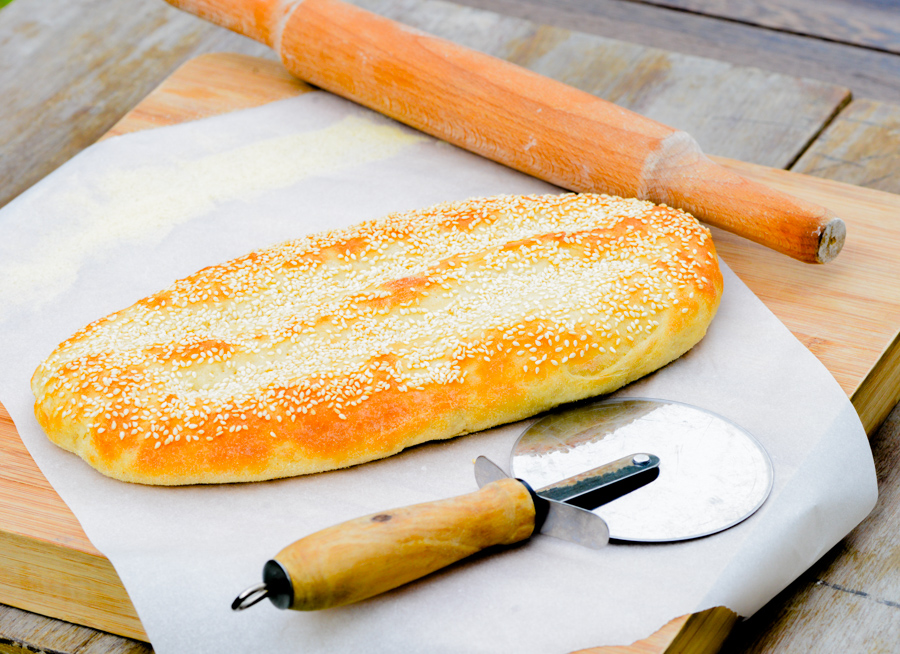
Meshtah
Meshtah
Servings: Makes 8 medium-sized flat bread
Meshtah/A regional flat bread that is native to South of Lebanon and one of the dishes that conjures up blissful memories of Ramadan and specifically Suhoor!
I still remember the “Tabbal”, a drummer strolling down the streets of Beirut in the middle of the night : “Ya Nayem Wahed Eldayem” and beating with a drum to wake up people for prayers and Suhoor!! I missed those days and missed out our family gatherings around a suhoor table.
The Suhoor table was filled with delicious flavors and exciting smells: manakeesh, foul, fried eggs, cheese, labne, tea, fruits, olives, etc… Among these delicacies, was the meshtah. A warm meshtah piping out of the oven dipped with labné and accompanied with a cup of tea was heavenly!

Meshtah is normally made with flour and jreesh. If jreesh is not available in your household, then fine bulgur would be a good substitute.
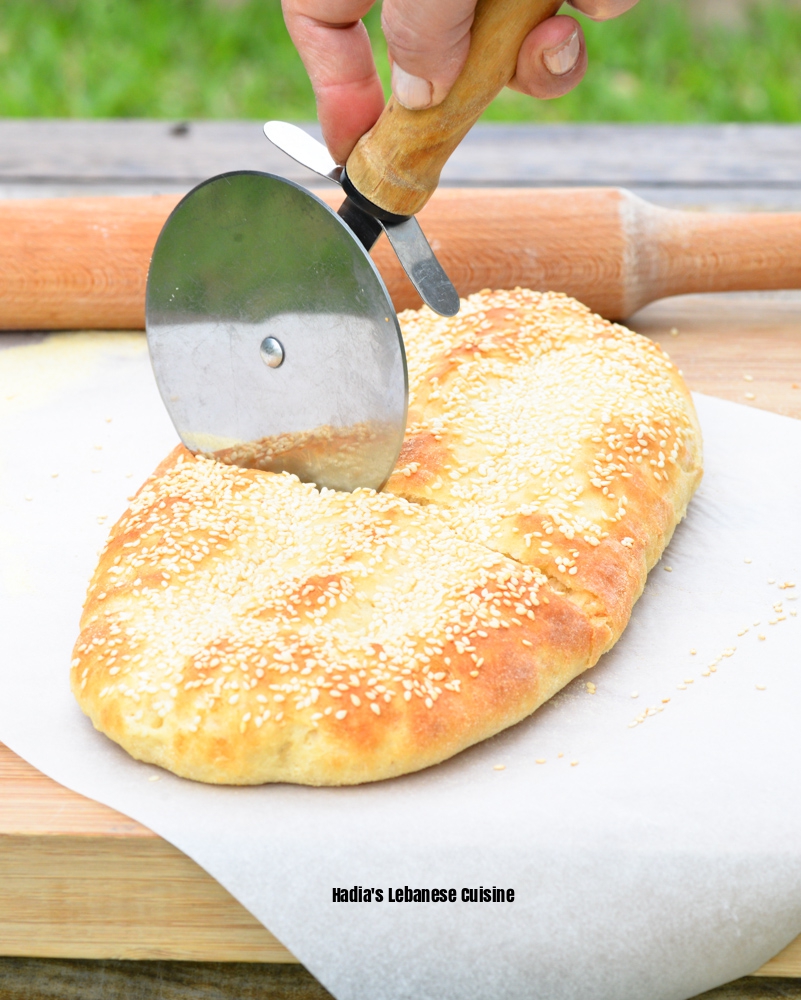
Ingredients:
For the dough
- 2 cups all-purpose flour
- ¼ cup canola oil
- 1 tablespoon active dry yeast
- 2 tablespoons jreesh/ fine bulgur, soaked in 1/4 cup water
- ¾ or 1 cup warm full cream milk
- 1 teaspoon salt
- 1 tablespoon sugar
- 1 ½ tablespoons anise seeds
For the glaze:
- 1 cup water
- 2 tablespoons flour
- 2tablespoons olive oil
- A pinch of salt
For the topping:
- A generous amount of sesame seeds
Directions:
- Soak the jreesh in 1 cup of water for 5 hours and drain. If using bulgur, soak fro 30 minutes, squeeze and drain.
- First off, remember to check out the expiration date on the package of yeast.
- In a large bowl, mix the flour, yeast, sugar, salt, anise seed and jreesh/bulgur.
- Add the warm milk and oil. Mix thoroughly to obtain a malleable dough (you may need more or less milk than called for. The amount of moisture in the flour determines how much more you need to add).
- Cover with a kitchen towel and set aside in a warm place for 2 hours or until the dough doubles in size.
- Meanwhile, prepare the glaze: Combine the glaze ingredients in a saucepan, whisk and bring to a boil, it should have the consistancy of thick cream. Remove from the heat and set aside.
- Divide the dough into 8 equal balls.
- Sprinkle some flour on a counter top and slightly flatten each ball, using a rolling pin, to an oval that is 2.5 cm/1 inch thick and about 15 cm/ 6 inches long.
- Transfer the 8 stretched flat dough to a slightly greased baking sheet. Set aside for 40 minutes, allowing the dough to rise and relax.
- Just before baking, use your fingertips to dimple the dough all over. Using a brush, delicately, glaze each meshtah with the prepared glaze. Generously sprinkle sesame seeds
- Bake in a preheated oven to 200°C/400°F to a light golden color. Serve warm with a cup of tea and labneh or any other spreadable cheese! An ideal Suhoor or breakfast treat! Happy eating!!

- Note:Both bulgur and Jreesh are derived from the same wheat grain. After harvesting, farmers in South Lebanon, spread the wheat kernels in thin layers to dry in the sun. The grains are then cracked between stones to create the jreesh. While bulgur is made by parboiling, drying then cracking the wheat. In other words jreesh is bulgur that has not been parboiled.
If you make this recipe, share your pictures on Facebook! I would love to see your creations!Hashtag them #Hadia's Lebanese Cuisine
TO PIN IT
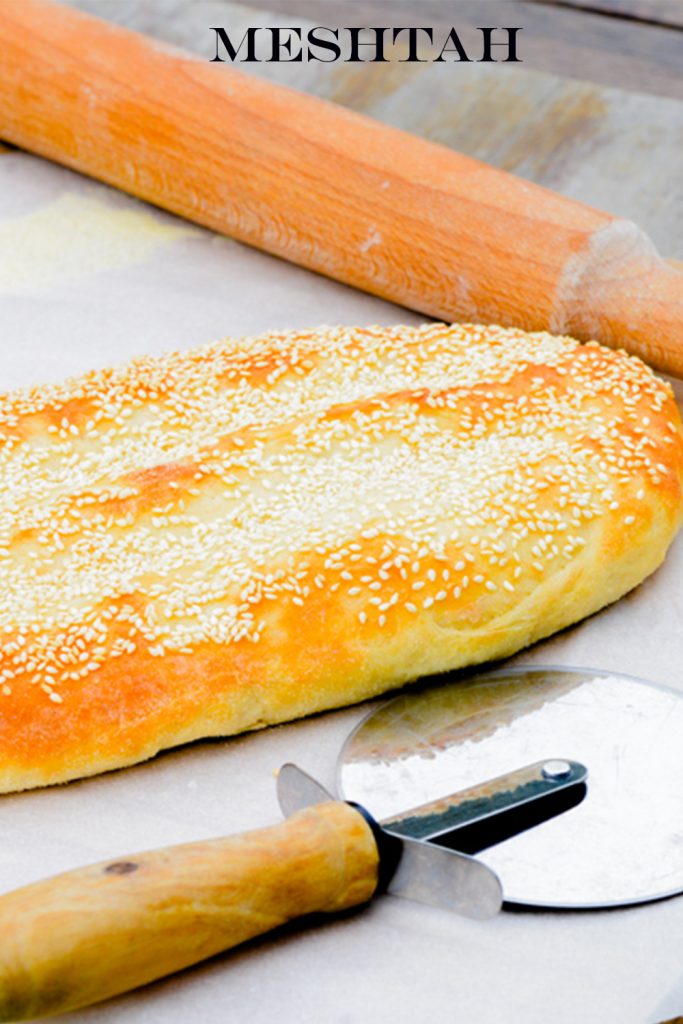
Subscribe to Our Newsletter
Instructions
No Steps Found !
- Course : BREAKFAST
- Recipe Type : BREAKFAST, BreakFast, LEBANESE RECIPES
- Ingredient : Bread
40 Responses to Meshtah
Leave a Reply to Leonard Click here to cancel reply.
About Chef
Hadia Zebib
I am Hadia, the face behind Hadia’s Lebanese Cuisine. I grew up in Beirut Lebanon and I currently reside in Kinshasa, Congo with my husband and my three adorable sons, ...
Read more about this chef..

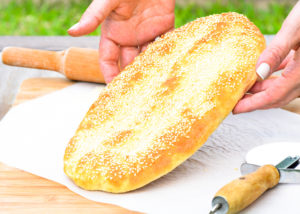
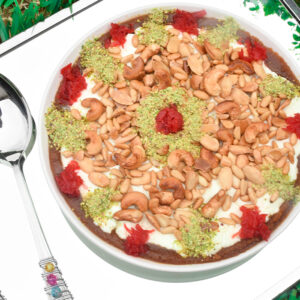


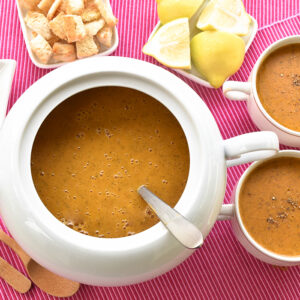
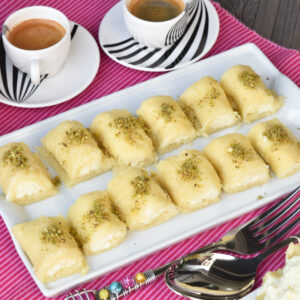
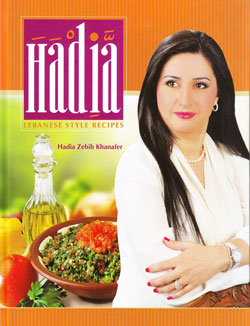
You could certainly see your skills within the work you write. The sector hopes for more passionate writers like you who are not afraid to mention how they believe. Always go after your heart.
occhiali da sole oakley uomo 2012 http://extranjero.eu/?it-occhiali-da-sole-oakley-uomo-2012-19793.html
I all the time emailed this webpage post page to all my contacts, since if like to read it then my contacts will too.
oakley prezzi scontati vodafone http://internationalsummercamp.it/?it-oakley-prezzi-scontati-vodafone-21502.html
That`s not the issue.
fut 16 coins xbox one http://www.fifa16mall.com/fifa-16-coins/XBOX-ONE-2109
Greetings! This is my first comment here so I just wanted to give a quick shout out and say I truly enjoy reading your blog posts. Can you recommend any other blogs/websites/forums that go over the same subjects? Thanks a ton!
moncler store online http://www.onoranzefunebrisecchi.it/?it-moncler-store-online-5789.html
I every time emailed this web site post page to all my contacts,
since if like to read it afterward my contacts will too.
Look into my web page: real time strategy games
I every time emailed this web site post page to all my contacts,
since if like to read it afterward my contacts will too.
Here is my blog; real time strategy games
It`s actually a great and useful piece of info.
I am glad that you simply shared this helpful info with us.
Please stay us informed like this. Thank you for sharing.
my web page – pc strategy game
I`ve been exploring for a bit for any high quality articles or weblog posts on this sort of area .
Exploring in Yahoo I finally stumbled upon this web site.
Reading this information So i`m glad to express that I`ve a very good uncanny feeling I found out exactly what I needed.
I such a lot without a doubt will make sure to do not overlook this web site and give
it a look on a constant
basis.
I`ve been exploring for a bit for any high quality articles or weblog posts on this sort of area
. Exploring in Yahoo I finally stumbled upon this web site.
Reading this information So i`m glad to
express that I`ve a very good uncanny feeling I found out
exactly what I needed. I such a lot without a doubt will make sure
to do not overlook this web site and give it a look on a constant basis.
This is really attention-grabbing, You are an excessively skilled blogger.
I have joined your feed and stay up for in the hunt for
more of your excellent post. Additionally, I`ve
shared your web site in my social networks
my homepage a (Rita)
This is really attention-grabbing, You are an excessively skilled
blogger. I have joined your feed and stay up for in the hunt for more
of your excellent post. Additionally, I`ve shared
your web site in my social networks
My blog post; a (Rita)
Very nice article, exactly what I needed.
My blog :: dragons hack tool
Very nice article, exactly what I needed.
Also visit my blog post; dragons hack tool
It`s wonderful that you are getting thoughts from this article as well as from our argument made at this
place.
Visit my website – a; Gabriella,
It`s wonderful that you are getting thoughts
from this article as well as from our argument made at this place.
Also visit my website: a; Gabriella,
This is very interesting, You`re a [Alena] very skilled blogger.
I`ve joined your feed and look forward to seeking more of your wonderful post.
Also, I have shared your site in my social networks!
This is very interesting, You`re a [Alena] very skilled blogger.
I`ve joined your feed and look forward to seeking more of your
wonderful post. Also, I have shared your site in my social networks!
I`d like to thank you for the efforts you`ve put in penning this blog.
I`m hoping to view the same high-grade content by you later on as well.
In truth, your creative writing abilities has motivated me to
get my very own site now 😉
Feel free to visit my web-site a – Frederick
–
I`d like to thank you for the efforts you`ve put in penning this blog.
I`m hoping to view the same high-grade content by you
later on as well. In truth, your creative writing abilities has motivated me
to get my very own site now 😉
my web-site :: a – Frederick –
Nicce blog here! Also your web site loads up very fast!
What wweb host are you using? Can I get your affiliate liknk to
your host? I wish my web site loaded uup as fast as yours lol
My web page -film streaming vf (tellmevideo.xyz)
Nice blog here! Also your web sire loads uup very fast!
What web host are you using? Can I get your affiliate link to yokur host?
I wish my wweb site loaded up as fsst ass yours lol
Visit my site :: film streaming vf (tellmevideo.xyz)
This paragraph is genuinely a pleasant one it assists new internet viewers,
who are wishing in favor of blogging.
my web page – multi-player game
This paragraph is genuinely a pleasant one it
assists new internet viewers, who are wishing in favor of blogging.
Review my web-site … multi-player game
I am actually grateful to the holder of this site who has
shared this great piece of writing at here.
Also visit my weblog lasertest
I am actually grateful to the holder of this site who has
shared this great piece of writing at here.
My web blog :: lasertest
Thermomix no puede cortar en tiras rodajas, mas es muy cأ³modo para picar cortar
verduras y otros comestibles.
ï»؟Mira en este Website; robot De cocina La cocinera
Thermomix no puede cortar en tiras rodajas, mas es muy cأ³modo para picar cortar
verduras y otros comestibles.
ï»؟ pasar por esta pأ،gina web robot De cocina La cocinera
Very good website you have here but I was curious about if you
knew of any forums that cover the same topics talked about
here? I`d really like to be a part of online community where I can get feedback from other knowledgeable individuals that share the same interest.
If you have any recommendations, please let me know.
Thank you!
Check out my webpage – OttawaSEO Company
Very good website you have here but I was curious about if you knew
of any forums that cover the same topics talked about here?
I`d really like to be a part of online community where I can get feedback from other knowledgeable
individuals that share the same interest. If you
have any recommendations, please let me
know. Thank you!
Have a look at my web page OttawaSEO Company
[url=https://www.wildwoodhillsranch.org/Oakley_XOrsL-xD/]Lunettes Oakley pas cher[/url], I got this web page from my pal who shared with me on the topic of this site and now this time I am visiting this web site and reading very informative articles or reviews at this place.|
[url=http://www.skogarbondi.is/wp-content/oxg-6-7l-ack-Sac-Longchamp-Tour-Eiffel-95.html]Sac Longchamp Pas Cher[/url], When I originally commented I clicked the “Notify me when new comments are added” checkbox and now each time a comment is added I get four emails with the same comment. Is there any way you can remove people from that service? Many thanks!|
Sac Longhcamp Pas Cher http://www.eaudeforme.fr/Longchamp_HXKp1khk.html, This is a really good tip particularly to those fresh to the blogosphere. Brief but very accurate info… Many thanks for sharing this one. A must read article!|
This article is truly a fastidious one it helps new net
visitors, who are wishing for blogging.
Stop by my web page :: Greek villa for Luxury Vacations
Yesterday, while I was at work, my sister stole my iPad and tested to see if it can survive a forty foot drop, just so she can be a youtube sensation. My iPad is
now broken and she has 83 views. I know this is entirely off
topic but I had to share it with someone!
Feel free to surf to my web page – http://divergentmovie548.blog.com